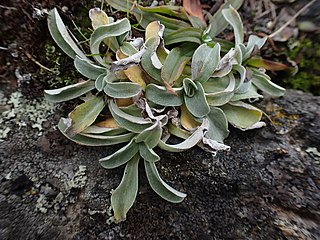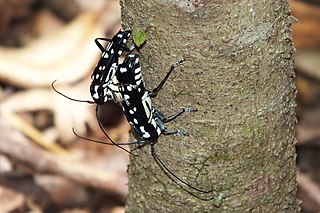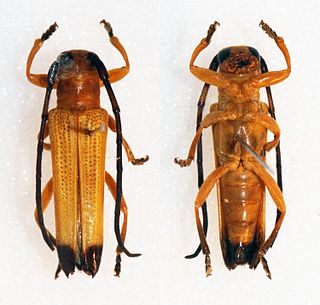
Glenealy is one of the few roads or streets without a suffix in Hong Kong. Located in the Mid-Levels on the Hong Kong Island, Hong Kong, it starts from Ice House Street and goes uphill to Hong Kong Zoological and Botanical Gardens, across Robinson Road and ends at Hornsey Road and Conduit Road.

Neotinea ustulata, the burnt orchid or burnt-tip orchid, is a European terrestrial orchid native to mountains in central and southern Europe, growing at up to 2,400 m (7,900 ft) elevation. The plant is considered Endangered in Great Britain and Least Concern internationally based on IUCN Red List criteria. The burnt-tip orchid was voted the county flower of Wiltshire in 2002 following a poll by the wild flora conservation charity Plantlife.
The Wicklow Senior Hurling Championship is an annual club hurling competition organised by the Wicklow County Board of the Gaelic Athletic Association and contested by the top-ranking senior clubs in the county of Wicklow in Ireland, deciding the competition winners through a group and knockout format. It is the most prestigious competition in Wicklow hurling.

The R752 road is a regional road in County Wicklow, Ireland. From its junction with the R772 in Rathnew on the outskirts of Wicklow Town it takes a generally south-westerly route to its junction with the R747 in the village of Woodenbridge, where it terminates. The road is 26 km (16 mi) long.

Glenealy is a village 8 km (5 mi) west of Wicklow Town, in County Wicklow, on the R752 road. The Dublin–Rosslare railway line also passes through the village.
Partulina ustulata is a species of tropical air-breathing land snail, a terrestrial pulmonate gastropod mollusk in the family Achatinellidae. This species is endemic to Hawaii in the United States.

Baetica ustulata is the only species of bush crickets in the monotypic genus Baetica.

The Helcomyzidae are a small family of flies in the Acalyptratae. The larvae feed on kelp and other organic matter washed up on shorelines. Species diversity is highest in New Zealand and south temperate South America. They are sometimes allied with the families Dryomyzidae or Coelopidae.
Mitromorpha ustulata is a species of sea snail, a marine gastropod mollusk in the family Mitromorphidae.

Peristernia ustulata is a species of sea snail, a marine gastropod mollusk in the family Fasciolariidae, the spindle snails, the tulip snails and their allies.

Nebularia ustulata is a species of sea snail, a marine gastropod mollusc in the family Mitridae, the miters or miter snails.
The 2005–06 All-Ireland Senior Club Hurling Championship was the 36th staging of the All-Ireland Senior Club Hurling Championship, the Gaelic Athletic Association's premier inter-county club hurling tournament. The championship began on 30 October 2005 and ended on 17 March 2006.

Glenealy Hurling Club is a Gaelic Athletic Association club located in the parish of Glenealy and Ashford in County Wicklow, Ireland. The club was founded in 1885 as a football club but switched codes to the game of hurling in the early 1920s.

Glenea is a genus of longhorn beetles belonging to the family Cerambycidae, subfamily Lamiinae.

Hemipepsis ustulata is a species of tarantula hawk wasp native to the Southwestern United States. Tarantula hawks are a large, conspicuous family of long-legged wasps that prey on tarantulas. They use their long legs to grapple with their prey before paralyzing them with a powerful sting. Their stings are ranked as some of the most painful in the insect world according to the Schmidt sting pain index. They are solitary, displaying lekking territorial behavior in their mating rituals.

Gamochaeta ustulata, commonly named featherweed or Pacific cudweed, is a North American species of flowering plant in the family Asteraceae. It is native to the western United States and southwestern Canada, in British Columbia, Washington, Oregon, and California. It is found primarily on seaside hills and in the Coast Ranges, with additional populations inland.

Glenea venus is a species of beetle in the family Cerambycidae. It was described by James Thomson in 1865. It is known from Papua New Guinea, Australia and Indonesia.

Glenea dimidiata is a species of beetle in the family Cerambycidae. It was described by Johan Christian Fabricius in 1801. It is known from Malaysia and Indonesia.

Nupserha ustulata is a species of beetle in the family Cerambycidae. It was described by Wilhelm Ferdinand Erichson in 1834. It is known from the Philippines and Malaysia.

Caladenia ustulata, commonly known as brown caps, is a plant in the orchid family Orchidaceae and is endemic to New South Wales and the Australian Capital Territory. It was first formally described in 2007 by David Jones who gave it the name Stegostyla ustulata and published the description in The Orchadian. In 2010 Gary Backhouse changed the name to Caladenia ustulata and published the change in The Victorian Naturalist. The specific epithet (ustulata) is a Latin word meaning "scorched", "singed" or "browned". Brown caps occurs in the southern tablelands and south-west slopes, which includes the Australian Capital Territory.















